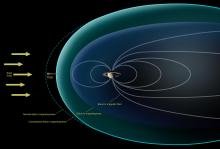Listen to today's episode of StarDate on the web the same day it airs in high-quality streaming audio without any extra ads or announcements. Choose a $8 one-month pass, or listen every day for a year for just $30.
You are here
Saturn III
The planet Saturn gives more than it gets. It radiates almost twice as much energy into space as it receives from the Sun. That internal heat powers most of the planet’s complicated weather.
Saturn is nine and a half times farther from the Sun than Earth is, so each square foot of the giant planet receives only about one percent as much sunlight. That’s not enough energy to power the storms seen in Saturn’s thick atmosphere. So most of the energy has to come from inside.
There are a couple of leading ideas for the sources of Saturn’s internal heat. One is that at least some of it is left over from Saturn’s formation, stored in its core.
The other says there’s a “rain” of liquid helium. As the droplets descend through Saturn’s great bulk, they pick up speed. As they move into denser layers, friction slows them down, which generates heat. The heat rises back toward the surface, where it powers big storms and some of the fastest jet streams in the solar system. Every few decades, a monster storm breaks out. It can cover an area many times bigger than Earth, and last for months — all powered by Saturn’s own heat source.
And right now, you can’t tell that Saturn receives little sunlight just by looking at it. The planet is shining like a bright golden star. In fact, it’s at its brightest for the entire year. Saturn is low in the southeast as night falls, scoots across the south during the night, and sets around sunrise.
Script by Damond Benningfield






